1934-1950 - Melbourne's war - Coins and medals - Timeline and pictures
By Museum Victoria | Thursday, 22 November 2007
By 1942, Melburnians and all Victorians were consumed by the war effort. While thousands of servicemen and servicewomen were fighting overseas, those who remained were actively involved in production, surveillance, disaster preparation and keeping the city operating.
The death of loved ones was a daily fear. In some cases only the service medals returned.
Professional Photographers' medal, 1934
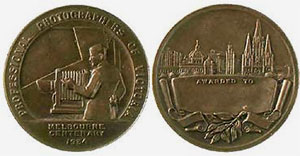
The Victoria and Melbourne Centenary celebrations in 1934-35 inspired numerous sporting, artistic and social events. This is a prize medal struck for the Professional Photographers of Victoria Melbourne Centenary competition.
Obverse - A photographer operating a large format bellows camera. Around him is the legend PROFESSIONAL PHOTOGRAPHERS OF VICTORIA MELBOURNE CENTENARY 1934.
Reverse - View of Melbourne down Swanston Street from the south bank of the Yarra. Below is a plaque with the legend AWARDED TO (it is not inscribed with a winners name).
Australasian Institute of Mining and Metallurgy award, about 1935
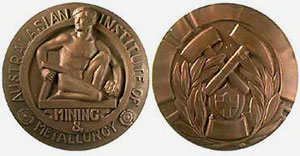
Artistically, this is one of the most striking Australian prize medals of the first half of the 20th Century. It can be dated as much by its style as by reference to dates on awarded examples, which are from the mid 1930s.
Obverse - Naked young miner crouching on an anvil and holding a pick and a lump of ore. Around him is the legend AUSTRALASIAN INSTITUTE OF MINING & METALLURGY. Tiny letters PM on the left side of the '&' are thought to be the artists initials. The word STOKES on the other side is the name of the private mint in Melbourne where the piece was struck.
Reverse - A crossed hammer and pickaxe at the top of a wreath and above a cross-shaped shield. Around this is a ribbon on which the name of the recipient would be engraved together with the year of the award.
Vacuum Oil 40th Anniversary medal, 1935
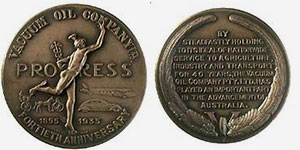
This commemorative features the Roman god Mercury and depicts improvement in transport - from horse-drawn carts and penny-farthing cycles to modern cars and aircraft. The medals were struck by the private Melbourne mint Stokes.
Obverse - The god Mercury flying to the right on winged feet. Behind him above the date 1895 are a horse-drawn vehicle and a man on a penny-farthing bicycle. In front of him above the date 1935 are a current model car and aircraft. Mercury's body divides the word PROGRESS. Around is rim the legend VACUUM OIL COMPANY FORTIETH ANNIVERSARY.
Reverse - Within a wreath of wings that meet at a letter V (for Vacuum) set around a wheel is the legend BY STEADFASTLY HOLDING TO ITS IDEAL OF NATIONWIDE SERVICE TO AGRICULTURE INDUSTRY AND TRANSPORT FOR 40 YEARS, THE VACUUM OIL COMPANY PTY. LTD. HAS PLAYED AN IMPORTANT PART IN THE ADVANCEMENT OF AUSTRALIA.
Frankston Scouting Jamboree medal, 1935
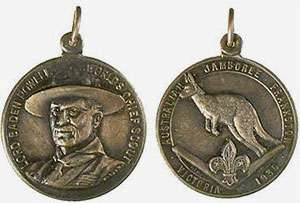
One of the major events of the Centenary celebrations of 1934-35 was the Australian Scouting Jamboree held in Frankston in 1935. This medal was struck as a memento of the event.
Obverse - Bust of Lord Baden Powell in a scouting uniform around which is the legend around LORD BADEN POWELL WORLD'S CHIEF SCOUT.
Reverse - A kangaroo facing left, above a boomerang and the scout emblem. Around these is the legend AUSTRALIAN JAMBOREE FRANKSTON VICTORIA 1935.
The King's Medal Royal Australian Military College, 1936
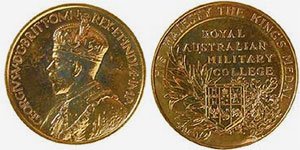
This is a portrait of King George V who reigned from 1910 until 1936. The portrait is by the Melbourne-born artist Sir Edgar Bertram MacKennal.
Obverse - Crowned bust of King George V facing left. Around it is the Latin legend GEORGIVS V D.G.BRITT.OMN.REX.ET INDIAE.IMP. [George the Fifth by the Grace of God King of all the Britons and Emperor of India].
Reverse - Australian arms within native flora, with the legend HIS MAJESTY THE KING'S MEDAL Royal Australian Military College.
Kingsford-Smith commemorative medal, 1935
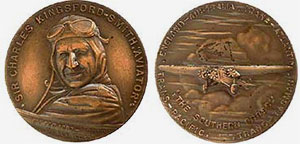
This medal was struck to commemorate the career of aviator Sir Charles Kingsford Smith. Produced by the Numismatic Association of Victoria, it features a portrait of 'Smithy' who lost his life in an attempt to fly from England to Melbourne in 1935.
Obverse - Bust of Kingsford-Smith with the legend around SIR CHARLES KINGSFORD-SMITH, "AVIATOR". Below are the dates 9th Feb. 1837 - 9th Nov. 1935.
Reverse - The three-engined Fokker plane 'Southern Cross' depicted flying among clouds. Around it is the legend ENGLAND - AUSTRALIA. TRANS-ATLANTIC. TRANS-PACIFIC. TRANS-TASMAN. THE "SOUTHERN CROSS".
Edward VIII coronation medal, 1936
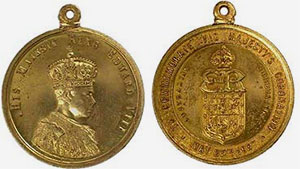
This medal was produced for Australian school children on the occasion of the coronation of Edward VIII in May 1937. The coronation never took place as Edward abdicated in order to marry Mrs Wallis Simpson in December 1936. The medals were never distributed.
Obverse - Bust of King Edward VIII facing right. Around it is the legend HIS MAJESTY KING EDWARD VIII.
Reverse - A crowned monogram ER over the Australian arms. Around them is the legend TO COMMEMORATE HIS MAJESTY'S CORONATION MAY 27TH 1937 AUSTRALIAN CELEBRATIONS.
Australian crown, 1937

This coin features a portrait of King George VI who reigned from 1936 to 1953. It is an Australia crown (five shilling) piece, a denomination struck in Melbourne in 1937 and 1938. This example is a special 'proof' striking acquired from the Melbourne Mint in 1937.
Obverse - Head of King George VI facing left. Around him is the Latin legend GEORGIVS VI D: G: OMN: REX F: D: IND: IMP: [George the Sixth by the Grace of God, King of all the Britons, Defender of the Faith, Emperor of India].
Reverse - A crown surrounded by the legend COMMONWEALTH OF AUSTRALIA ONE CROWN 1937. The small letters KG below the right corner of the crown are the initials of the artist George Kruger Gray.
George VI coronation medal, 1937
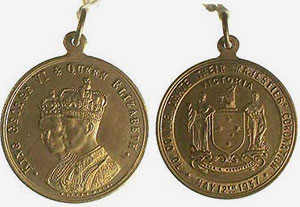
This is an example of the commemorative medal distributed to Victorian school children to celebrate the coronation of King George VI in 1937. The coronation date was 12 May, fifteen days earlier than the date intended for the coronation of Edward VIII.
Obverse - Crowned conjoined busts of the King and Queen with the legend KING GEORGE VI & QUEEN ELIZABETH.
Reverse - The arms of Victoria with the legend TO COMMEMORATE THEIR MAJESTIES CORONATION MAY 12TH 1937.
Australia's 150th Anniversary medal, 1938

This medal was struck in 1938 to commemorate the 150th anniversary of British settlement of Australia. It depicts Australia standing with the sun behind her head. At her feet kneel two men, one representing industry (with tools, city buildings and shipping) and the other representing agriculture (with sheep, fruit, silos and an aircraft).
Obverse - Australia receiving gifts from Industry and Agriculture. Below are the arms of Australia and the dates 1788 and 1938.
Reverse - Above a beehive set among produce is the legend AUSTRALIA'S 150TH ANNIVERSARY 1938. The word AMOR in small letters below the hive is the name of the private mint that struck the medal.
Catholic centenary medal, 1939
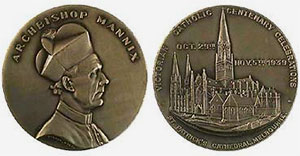
This medal was produced in 1939 to commemorate the centenary of the Catholic Faith in Victoria. It features Archbishop Mannix and St Patrick's Catherdal.
Obverse - A bust of the Catholic Archbishop with the legend ARCHBISHOP MANNIX.
Reverse - A view of St Patrick's Cathedral with the legend VICTORIA CATHOLIC CENTENARY CELEBRATIONS OCT. 29TH NOV. 5TH. 1939 ST. PATRICK'S CATHEDRAL, MELBOURNE.
HMAS Sydney medal, 1940
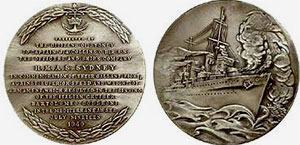
This is an example of the medal awarded to the Captain and crew of HMAS Sydney on 11 February 1941 when the ship returned to Australia after war service in the Mediterranean. Sailing off Western Australia later the same year the Sydney was sunk by a German raider with the loss of all 645 aboard.
Obverse - The legend PRESENTED BY THE CITIZENS OF SYDNEY TO CAPTAIN J.A.COLLINS CB.,R.A.N. THE OFFICERS AND SHIP'S COMPANY IN COMMEMORATION OF THEIR GALLANT FIGHT AGAINST SUPERIOR SPEED AND WEIGHT OF ARMAMENT, WHICH RESULTED IN THE SINKING OF THE ITALIAN CRUISER BARTOLOMEO COLLEONI IN THE MEDITERRANEAN SEA JULY NINETEEN 1940.
Reverse - HMAS Sydney under full steam with guns smoking.
Fund raising medals, 1941
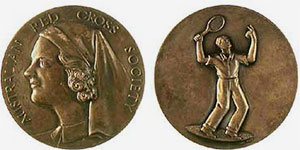
These two tennis prize medals reflect the use of sport as a fundraising activity in Melbourne during World War Two.
Obverse - Head of a nurse in uniform, facing right. Around her is the legend AUSTRALIAN RED CROSS SOCIETY.
Reverse - The figure of a man serving a tennis ball.

Obverse - A man preparing to hit a backhand tennis stroke. Below him in small letters is the artist's name and date, ALAN McCULLOCH '41.
Reverse - Military equipment above a plaque on which the winner's name might be inscribed. Around this is the legend THE LAWN TENNIS ASSOCIATION OF VICTORIA WORLD WAR II WAR FUNDS APPEAL.
John Medley portrait medal, 1942
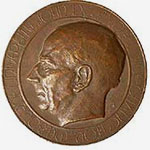
Andor Meszaros was one of many Europeans who sought refuge in Australia at the outbreak of World War Two. Although classified as an enemy alien and restricted in his movement about the country, he sought out artistic commissions, such as this portrait medal of Vice-Chancellor John Medley of the University of Melbourne.
Obverse - Head of John Medley by Andor Meszaros. Around it is the legend JOHN D.C. MEDLEY VICE-CHANCELLOR MELBOURNE UNIVERSITY.
Centenary of Incorporation of Melbourne medal, 1942
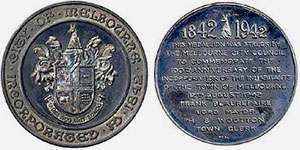
This medal was produced by the Melbourne City Council to commemorate the centenary of the incorporation of the city. It is believed that only 75 medals were struck.
Obverse - At the centre are the arms of the City of Melbourne. Around them on a broad rim is the legend CITY OF MELBOURNE INCORPORATED AD 1842.
Reverse - The dates 1842 and 1942 on either side of a half kangaroo (derived from the top of the City arms). Below them is the legend THIS MEDALLION WAS STRUCK BY THE MELBOURNE CITY COUNCIL TO COMMEMORATE THE 100TH ANNIVERSARY OF THE INCORPORATION OF THE INHABITANTS OF THE TOWN OF MELBOURNE. 12TH. AUGUST 1942. FRANK BEAUREPAIRE LORD MAYOR. H.S.WOOTTON TOWN CLERK.
Nunawading medal, 1945
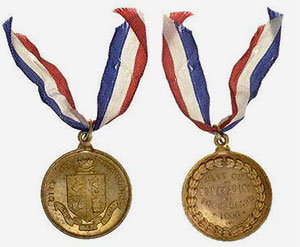
This medal was distributed to the residents of the City of Nunawading on the occasion of its proclamation in 1945.
Obverse - The City arms, around which is the legend around CITY OF NUNAWADING.
Reverse - Within a wreath is the legend CITY OF NUNAWADING PROCLAIMED 1945.
Australian florin, 1942
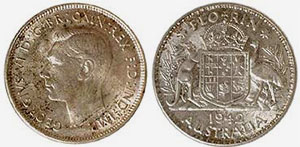
During World War Two both the Melbourne and Perth mints were heavily involved in war production. A need for additional coins, partly caused by the influx of US soldiers in Australia, was met by employing the USA mints of San Fransisco and Denver. This florin was struck in San Fransisco and has a small letter 'S' just above the date. Coins made at Denver bore the letter 'D'.
Obverse - Head of King George VI facing left. Around him is the Latin legend GEORGIVS VI D: G: OMN: BRITT: REX F: D: IND: IMP: [George VI by the Grace of God King of all the Britons Defender of the Faith Emperor of India].
Reverse - Crowned Australian arms supported by a kangaroo and emu. Above them is the denomination FLORIN and below are a small S and 1942 AUSTRALIA.
World War Two medal group, 1945
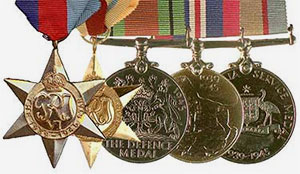
This group of war medals was awarded posthumously to Private R.B. Jinks who died when the Shun Tein, transporting Australian and Italian wounded from Tobruk, was torpedoed and sank in the Mediterranean on 23 December 1941. Jinks enlisted at Sale, Victoria and left Australia in 1939 with the 7th Battalion. The medals were presented to his foster-mother, Mrs F Chadwick.
The 1939-45 Star granted for service in operations during World War Two. The Africa Star granted for service in North Africa between 10 June 1940 (Italy's entry in the war) and 12 May 1943. The Defence Medal granted for service of at least six months. The War Medal 1939-45 awarded to full-time armed service personnel. The Australian Service Medal (1939-1945) awarded to members of the Australian Armed Forces serving in operational areas.
Mothers and Widows badge, 1945
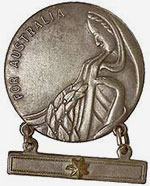
This is lapel badge was awarded to mothers and widows to mark the death of a child or husband on active service. Additional bars bearing a star were issued if further losses occurred.
Obverse - A woman in mourning with a section of a wreath and the legend FOR AUSTRALIA.
School's Peace medal, 1945
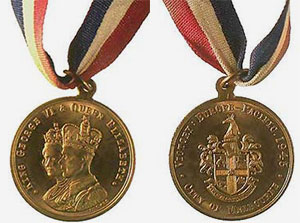
This medal was manufactured for the City of Melbourne to distribute to school children as part of the celebrations to mark the end of World War Two.
Obverse - Crowned conjoined busts of the King and Queen with the legend KING GEORGE VI & QUEEN ELIZABETH.
Reverse - At the centre are the arms of the City of Melbourne, around which is the legend VICTORY EUROPE - PACIFIC 1945 CITY OF MELBOURNE.
Debased metal coins, 1946
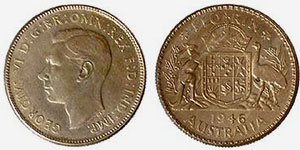
At the end of World War Two there was an increase in the price of silver around the world. At the time Australian coins were struck from a sterling silver alloy, 92.5 percent pure silver. This is one of four trial coins struck in nickel as an experiment for a new coin material. Eventually Australia decided not to drop silver totally and from 1946 adopted a 50 percent silver alloy in its silver coins.
Obverse - Head of the King facing left with the Latin legend around GEORGIUS VI D:G:BR:OMN:REX FID:DEF:IND:IMP.M [George VI by the Grace of God King of all the Britons Defender of the Faith Emperor of India.
Reverse - Australian arms with the legend FLORIN 1946 AUSTRALIA.



